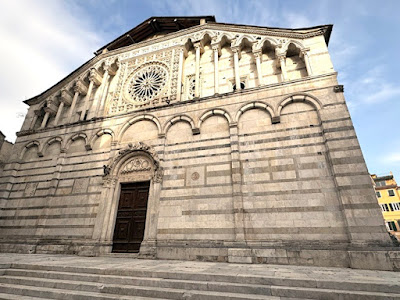Carrara
Carrara is a town and commune in Tuscany. Massa is its twin town. They form the province of Massa and Carrara, renowned for its white or blue-grey marble quarries. The earliest settlement is dated from 9th century BC. In 2nd century BC, the Romans built borough to house workers to quarry the marble. Marble was transported to the nearby harbor of Luni at the river Magra and shipped further for architectural use or sculpture creation. Notable examples are the Pantheon, David and Pietà from Michelangelo.
We stayed for a short while in the town of Carrara but had magnificent views over the beautiful white tip mountain ranges from different places. We arrived at Piazza Gramsci / d'Armi after parking our car. Originally the square was part of the princely garden. It underwent subsequent changes and became a public space at the end of 19th century. It is surrounded by elegant buildings and greens / trees dotted here and there. An enormous light grey marble statue of a fat woman on the left side of the square first caught our attention. A spectacular staircase flanks the right side of the square.
Sitting in the middle of the square is a monument of Pellegrino Rossi, an economist, politician and jurist who was born in Carrara. He got important educational and government positions and naturalized in Geneva, France and the Papal State. He proposed the establishment of a customs league between the Italian states but it was disliked by those who wanted to unite Italy as a centralized state. One morning, Rossi was stabbed. His assassination led a series of events that lastly the proclamation of the Roman Republic. Daughters of Jesus’ School (Scuole delle Figlie di Gesù) stands behind Rossi. The beautiful Apuan Alps act like the backdrop.
The Carrara Cathedral, dedicated to St. Andrew the Apostle (Sant'Andrea Apostolo), is the centerpiece of the ancient city. It is a combination of Romanesque and Gothic style and covered mainly with valuable Apuan marble. The exterior is bright, believed with restoration. The bottom part of the façade and the side elevations are Romanesque, while the portal, crowned by sculptures inspired by medieval bestiaries, and surmounted by an exquisite Gothic rose window with twisted columns, each different from the others, is consistent with the Gothic style of architecture in the 14th century.

In the square of the cathedral, there is the Giant’s Fountain, a statue by the artist Baccio Bandinelli.
Not far away from the Cathedral stands the residence which the world renowned and influential Michelangelo stayed.
Piazza Alberica is the largest and most important historical square in Carrara. It is named after Alberico I Cybo-Malaspina, who renovated it in the second half of the sixteenth century, making it the new place of economic power in the city. Piazza Alberica is surrounded by buildings of the Renaissance and Baroque period, characterized by their intense pink, red and yellow colours. Important buildings include Palazzo Diana (also known as Palazzo delle Logge), Palazzo Orsolini and the majestic Palazzodel Medico. Buildings of lesser importance belong to the Tenerani family and the Luciani family.
In the center there is a fountain with a basin and a marble lion, surmounted by a large statue of the Duchess Maria Beatrice d'Este (made in 1824 by the Carrarese sculptor Pietro Fontana) which stands on a high pedestal adorned with bas-reliefs.



















Comments